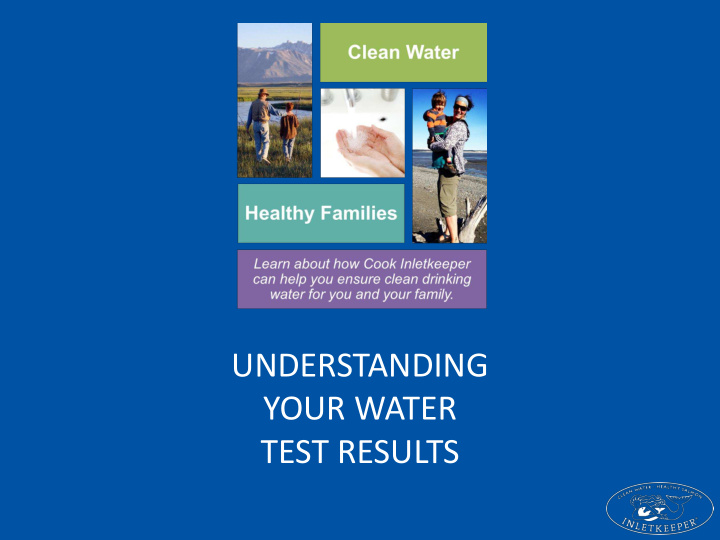



UNDERSTANDING YOUR WATER TEST RESULTS
Presentation Outline Confidentiality Interpreting Report Results Treatment Options Resources Questions?
Water Test Results are Individual meeting can be scheduled with Inletkeeper staff. Just email or call us. Sharing your results with Inletkeeper to get help with interpreting them DOES NOT allow us to disclose the data to others. If you wish to share the data with Inletkeeper, and allow us to use the data in maps and in discussions with other agencies, please fill out and sign our Data Use Agreement.
Report Results – Case Narrative
Report Results – Case Narrative cont’d
Report Results – Abbreviations
Maximum Contaminant Limits PRIMARY Potential adverse health effects – acute or chronic. SECONDARY Can cause an unpleasant odor, taste, or color, or cause appliances to malfunction. BOTH Some contaminants have a Primary MCL and a Secondary MCL. NIETHER Some contaminants are included on a candidate list, which the EPA periodically prioritizes to determine research and data collection efforts which may one day lead to regulation. Other criteria are not health concerns themselves, but may lead to other problems.
Maximum Contaminant Limits EPA List of all Primary and Secondary MCLs • http://water.epa.gov/drink/contaminants/index.cfm The EPA only requires testing and enforcement of these standards for public water systems, NOT private wells, cisterns, springs, etc. Your results are not required to meet EPA standards, but they are still great standards to use when assessing your household’s water for health and aesthetics.
Report Results – Units mg/L = milli gram per liter of water = parts per million (ppm) µ g/L = micro gram per liter of water = parts per billion (ppb) Some criteria were measured on a relative scale : pH and Langelier Index
Report Results – Results Table 1 2 3 4 5 6
Pay attention to any Flags listed in this column. An ‘H’ means that an EPA Not all parameters have an recommended EPA recommended MCL. If MCL has been Each test has a the parameter has one, it exceeded. specific analysis will be listed here. method, which enables the lab to assure quality control and quality assurance. The MCL for Manganese is 0.05 The result for Iron was less than The MRL shows the lowest mg/L. This test only found 0.0119 the MRL. This doesn’t mean that amount of contaminant Arsenic is mg/L, so the amount found was there was zero Iron, just that it present that the lab measured in less than the EPA set as the limit. was less than the test method equipment or method used micrograms per Good! could detect, 0.050 mg/L. in the lab could accurately liter. detect.
What do your results mean?
What do your results mean?
What do your results mean?
What do your results mean?
My result for _____________ was high! QUESTIONS TO ASK Is it a health risk? Are there aesthetic problems? What is causing the high level? What treatment options are there?
Treatment System Considerations Is the treatment system independently certified by NSF International or the Water Quality Association? Where will the water treatment system go? Point-of-use or point-of-entry? Whole house or just drinking water? Can non-treatment solutions address the problem (e.g., replacing septic system, repairing well cap, etc.)?
Ion Reverse Filter Distillation Exchange Osmosis Activated carbon bonds with and traps contaminants. Distillers heat water to the Effective at improving the Water softeners use a ion Reverse osmosis units force boiling point, and then taste of water, and may exchange resin, regenerated water through a collect the water vapor as it reduce lead, copper, and with sodium chloride or semipermeable membrane condenses, killing disease- other contaminants. potassium chloride, to under pressure, leaving causing microbes and leaving reduce the amount of contaminants behind. most chemical contaminants hardness (calcium, behind. Neutralizing filters use magnesium) in the water. crushed limestone, magnesia They are effective in or other mixture. As water eliminating all disease Removes nitrates, bacteria, passes through, the filter The hardness ions in the causing organisms and most sodium, hardness, dissolved neutralizes the excess “acid” water are replaced with chemical contaminants to be solids, most organic and results in the partial sodium or potassium ions. removed. compounds, and heavy dissolution of the media, metals. increasing the hardness of the water and raising the pH. Other “treatment” options include constructing a new well, connecting to a public utility, or using bottled water.
Ion Reverse Filter Distillation Exchange Osmosis Filters need to Can add Expensive Expensive be replaced sodium and periodically, salty taste to can be water expensive Typically point- Typically point- of-use (under of-use (under sink) sink) Point-of-use or Typically point- point-of entry of-entry (whole are both Slow Wastes water house) common
Local Water Treatment Resources Cook Inletkeeper does not endorse any organization, business, product, or water treatment action. HOMER - Alaska Quality Water Conditioning www.akqualitywater.com 235-5116 or toll free 1-866-269-4426 KENAI - Kenai Peninsula Water Treatment LLC http://kpwtllc.com/index.html 283-5832 KENAI - Water Systems and Service Company 776-8066 STERLING - Alaska’s H20 Pros 262-8711
Additional Resources Water Systems Council • http://www.watersystemscouncil.org/ • Safe Drinking Water Hotline 1-800-426-4791 • http://water.epa.gov/drink/index.cfm EPA • http://www.epa.gov/privatewells/pdfs/household_wells.pdf • http://water.epa.gov/drink/guide/upload/book_waterontap_full.pdf Alaska Department of Environmental • http://www.dec.state.ak.us/EH/dw/index.htm Conservation UAF Cooperative • http://www.uaf.edu/ces/nrcd/water/ Extension Service National Sanitation • www.nsf.org Foundation American Water Works • www.awwa.org Association Water Quality • www.wqa.org Association Cook Inletkeeper • http://inletkeeper.org/SAFEDRINKINGWATER
Cook Inletkeeper 3734 Ben Walters Lane, Homer, AK 99603 907.235.4068 dorothy@inletkeeper.org www.inletkeeper.org /safedrinkingwater Newsletters! Action Join Cook Alerts! Inletkeeper today! Events! www.inletkeeper.org Protecting Alaska’s Cook Inlet watershed and the life it sustains.
Recommend
More recommend